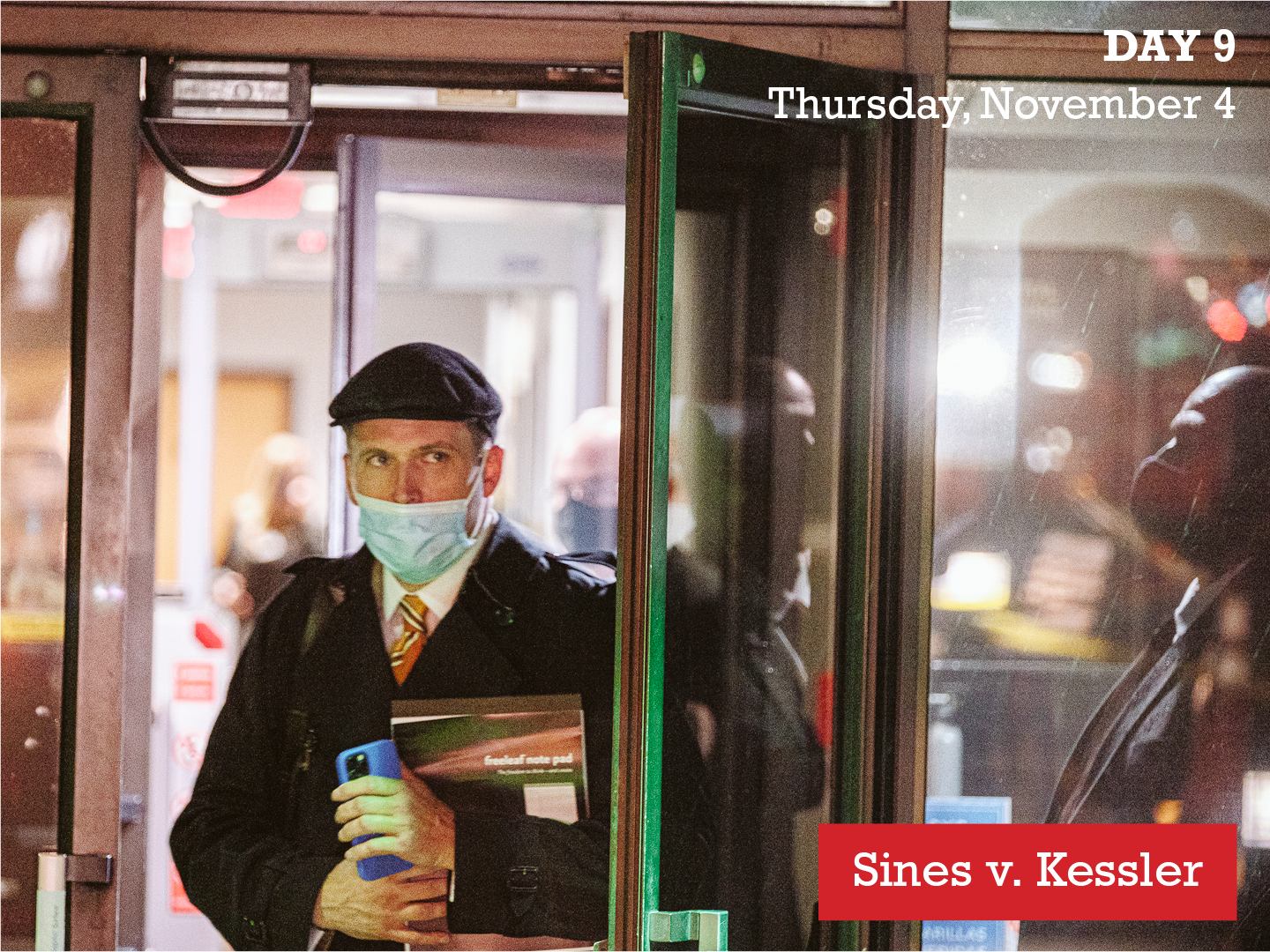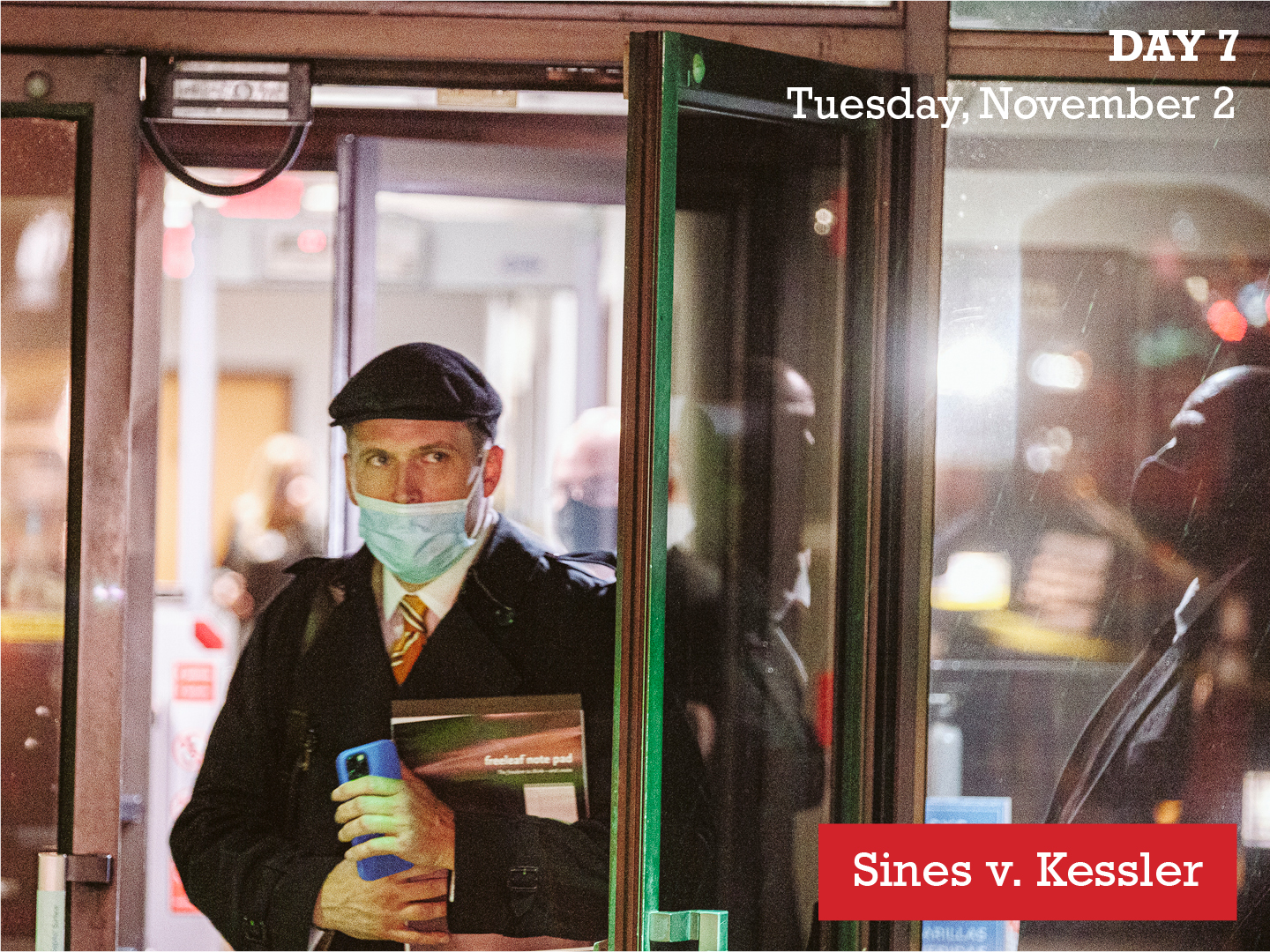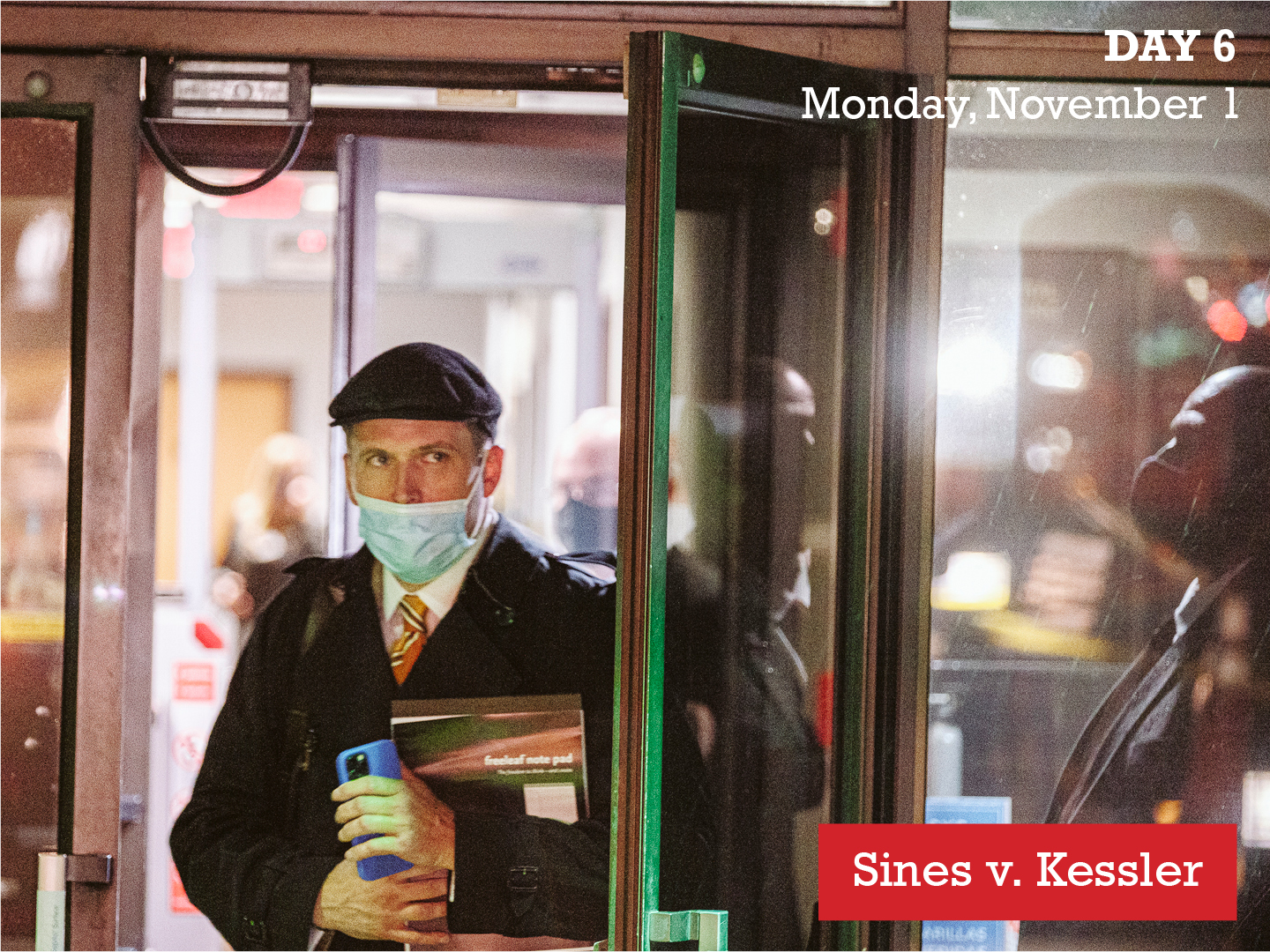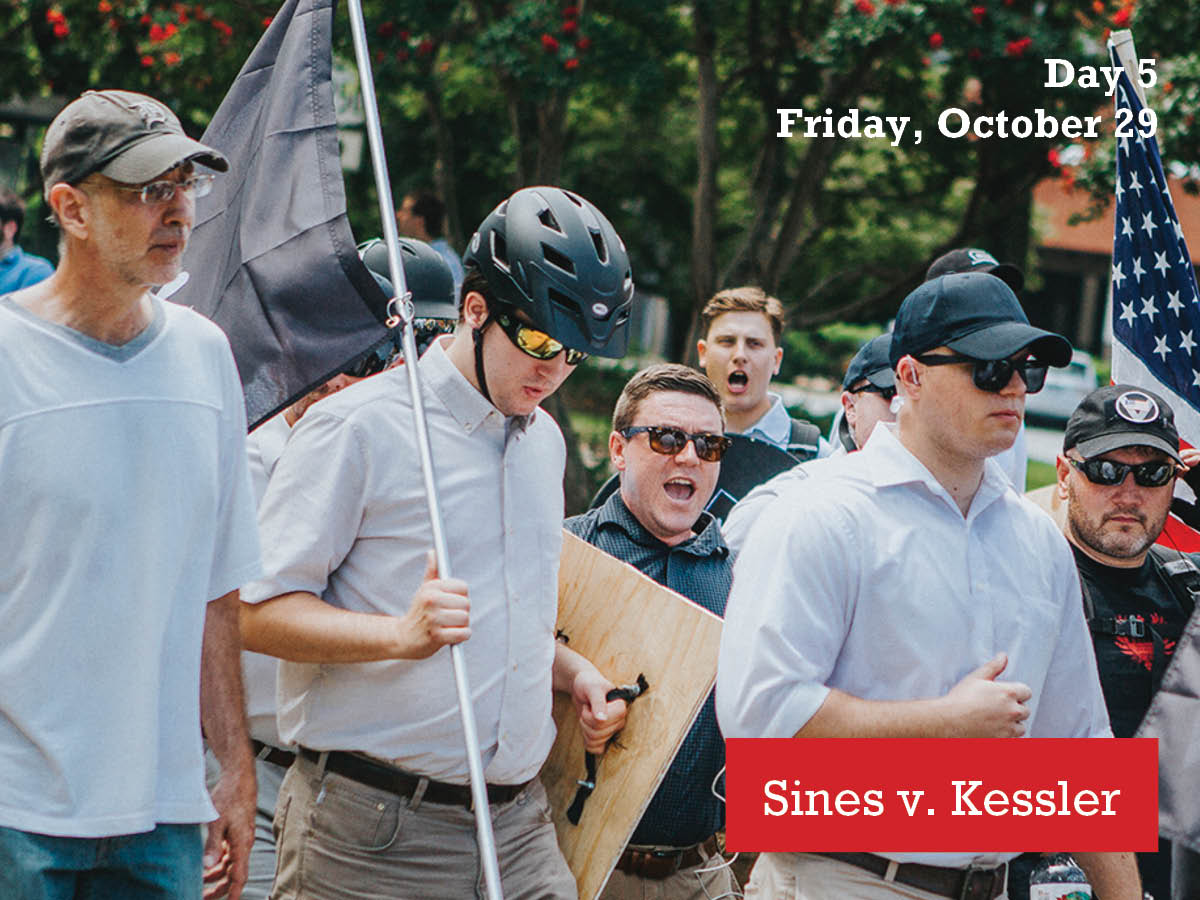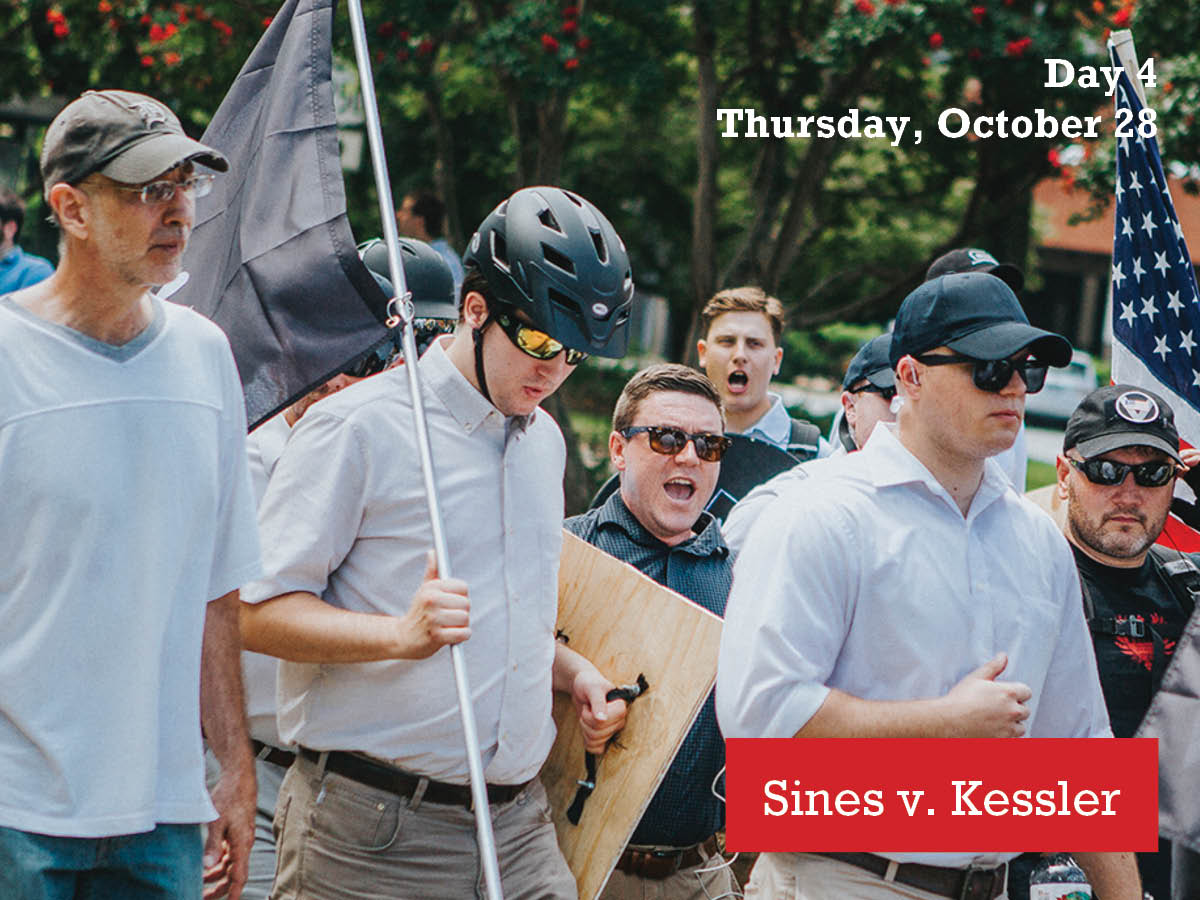Each day, we’ll have the latest news from the courtroom in the Sines v. Kessler Unite the Right trial. For coverage from previous days, check the list of links at the bottom of this page.
Alt-right message board discussions of a false flag attack, racist and antisemitic jokes, and disappearing evidence. Those were among the topics covered in a nearly full day of testimony on Tuesday from one of the men responsible for Nazi-inspired propaganda leading up to the Unite the Right rally in August 2017.
Traditionalist Worker Party co-founder Matthew Parrott took the stand as an adverse witness for the plaintiffs on the 12th day of the Sines v. Kessler trial. The lawsuit alleges Parrott and two dozen other defendants conspired to commit racially motivated violence at the infamous rally.
Parrott, an IT professional and self-described Christian, claimed he and his organization use only nonviolent means to accomplish their white nationalist goals, a claim that was repeatedly challenged by plaintiffs’ attorney Michael Bloch.
“Have you personally punched counterprotesters?” Bloch asked Parrott.
“I’m quite the physical coward. Not much of a fighter,” Parrott said, admitting he had punched a counterprotester at a rally in Terre Haute, Indiana. He described the act as self-defense because the counterprotester had assaulted one of Parrott’s white nationalist compatriots.
“I disabled the gentleman and turned him over to the Terre Haute city police,” said Parrott, insisting that the lack of any criminal charges against him for the incident support his claim that it was justified.
Bloch used Parrott’s online statements and exchanges leading up to the Unite the Right rally to poke more holes in his claims of nonviolence. He showed posts on the Discord server prior to Unite the Right in which Parrott participates in exchanges about violent acts. He pressed Parrott on his claim that TWP sanctioned people for promoting violence.
“The more violent you could make a rally, the more money you could make for your organization,” said Bloch.
“That’s a despicable misrepresentation of our party’s plans,” Parrott responded.
Parrott freely admitted to holding antisemitic and racist views, but said it was important to stay away from using racial slurs or the Nazi salute in public, to avoid unnecessary provocation. Bloch further challenged him on the claim that he eschewed violence, showing the jury an online exchange in which Parrott said he’d like to see his TWP co-founder Matthew Heimbach “chimp out” on counterprotesters at a rally in Anaheim.
“I was watching the live footage and lamenting it was boring to watch because everything was going safely. That was the joke,” Parrott replied, denying he’d intended the term as a racial slur or that he’d actually wanted to see Heimbach assault counterprotesters.
Bloch’s efforts to impeach Parrott as a witness continued as he compared Parrott’s social media posts and his testimony in a June 2020 deposition to his statements on the stand. He also asked Parrott about his connections to his fellow defendants, including Richard Spencer and Christopher Cantwell, both of whom are representing themselves in the case.
Parrott said he’d written several articles for Spencer’s alt-right website, and also knew Cantwell.
“He’s a radio shock jock,” Parrott chuckled, describing Cantwell. “I found him an amusing character.”
Bloch pointed out discrepancies in Parrott’s current description of Cantwell to his 2020 deposition in which he acknowledged Cantwell was a racist at the time of the rally.
“I did not realize during the time I was taking this deposition…” Parrott said.
“That there would be a record of it,” Bloch interjected.
“I did not understand while giving this deposition that the term racist would be redefined out from under what I meant it in the deposition,” Parrott said.
Bloch showed the jury an April 2017 exchange on the Discord server, in which multiple users discussed setting up a false flag attack, and blaming it on antifa, to stir tension and precipitate violence.
“Do you guys think it would be good to make generic antifa pages,” one poster writes.
“Yes, I had a fake antifa Facebook page,” responds another user called Dr. Cocoa Puff, whose real name is Corey Smith.
Bloch ended his direct examination of Parrott with a series of questions about evidence in the case that disappeared after the lawsuit was filed in Oct. 2017. Several white nationalists’ cell phones were damaged or lost, and Parrott wrote a Facebook post warning fellow white nationalists about their social media accounts.
“If you were involved in any altercation in Cville and you haven’t disabled your social media, you should do so,” Parrott wrote in the February 2018 post. “I know it’s a bit late for some folks…”
On cross-examination, the defense team—including Spencer and Cantwell—sought to distance Parrott from the other defendants, downplaying their relationships before August 2017 in an effort to undermine the conspiracy claim at the heart of the lawsuit.
Parrott said he’d written a few blog posts for Spencer’s website but had never been paid, and told defense attorney Josh Smith that he hadn’t collaborated with defendant Jeff Schoep in planning the Unite the Right rally or witnessed Schoep commit acts of violence that weekend.
Smith also asked Parrott about the success of other rallies in which he’d participated, including a white nationalist rally in Philadelphia on Columbus Day 2015. Despite a large turnout of counterprotesters at the event, Parrott said there was no violence.
“Everybody had a good time,” said Parrott. “It was safe, legal, and fun.”
The trial will continue until at least November 19, with court remaining in session on Veterans Day in an effort to conclude the proceedings on time.
Previous Sines v. Kessler coverage
Pre-trial: Their day in court: Major lawsuit against Unite the Right neo-Nazis heads to trial
Day one, 10/25: Trial kicks off with jury selection
Day two, 10/26: Desperately seeking jury
Day three, 10/27: Jury selection wraps up
Day four, 10/28: Plaintiffs and defendants make their opening arguments
Day five, 10/29: “I hear it in my nightmares,” says plaintiff Romero
Day six, 11/1: “I stopped being an outgoing, sociable person,” says plaintiff Willis
Day seven, 11/2: “Strike that”
Day eight, 11/3: Defendants fawn over Hitler
Day nine, 11/4: Quibbling about hate
Day 10, 11/5: League of the South takes the stand
Day 11, 11/6: “It gave me Nazi vibes”



